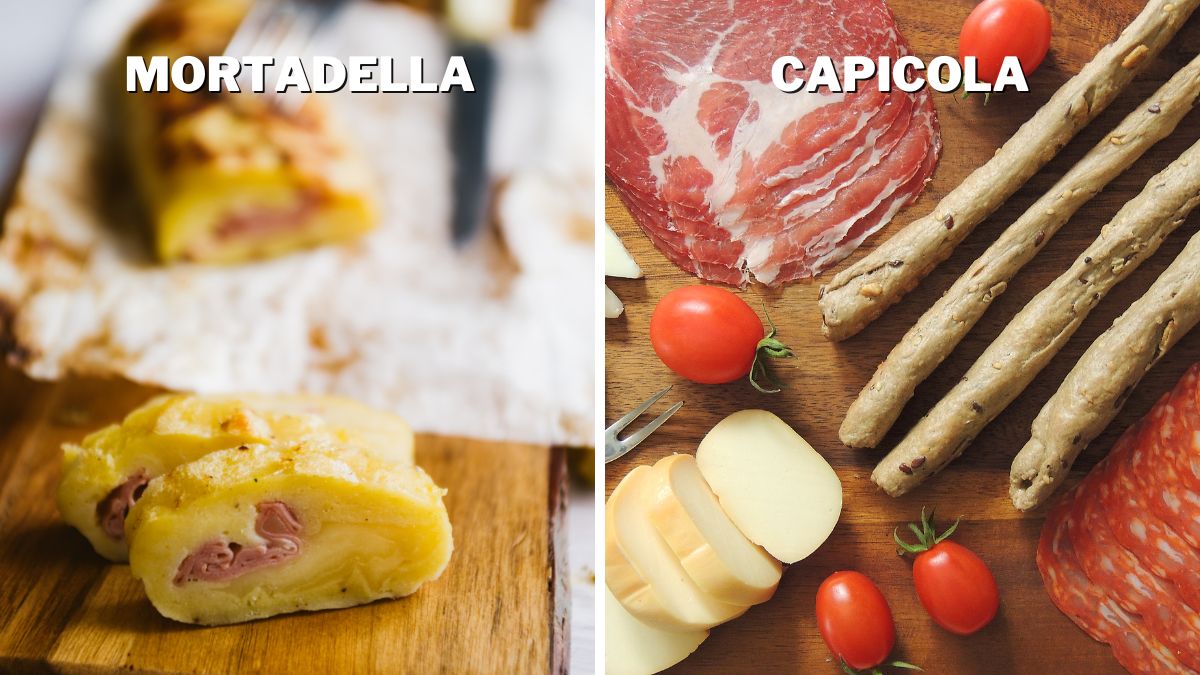Mortadella vs. Capicola: Differences & Which Is Better?

Deli meats are a big deal in Italy, so it’s no surprise that two of the best ones come from there – mortadella and capicola. For me, nothing compares to homemade ciabatta stuffed with arugula, tomatoes, mozzarella, and layers of mortadella. On the other hand, I enjoy capicola when served wrapped around melon, Provolone, or drizzled with honey and enjoyed with a glass of Shiraz. But what is the difference between mortadella and capicola?
Tender mortadella is minced pork, while salty capicola is the whole cut of shoulder muscle. Pistachios and olives are superb additions to mortadella, but herbal or spicy rubs are the choice for capicola. Mortadella can be ready in a day, yet drying capicola can last for up to 6 months.
For all my fellow sandwich lovers out there, capicola and mortadella are a must-try! They actually go very well together, stuffed between fresh-from-the-garden veggies and burrata. Read on to find out about their differences and everything else you have to know!
Ingredients and Preparation
High-quality pork is the meat of choice for both. Capicola only calls for neck and shoulder cuts, while mortadella is a mixture of shoulder cuts, pork trimmings, belly, and tripe. What’s more, for capicola, you’ll need about 30% fatty meat, but neck fat cubes for mortadella.
When speaking of preparation, the main difference is that capicola is a whole muscle cut, seasoned and cured, but pork for mortadella needs to be minced into almost a paste-like texture. Curing shoulder or neck muscles in sea salt and red pepper flakes for capicola is the first step, then you can choose different aromatic seasoning rubs according to your taste. Black peppercorns are a staple here, but adding fennel and aniseed will make an amazing classical spice blend.
If you want herbal relish, go for fresh rosemary, thyme, and garlic as Italian classics. But, to spice things up, jack up on red pepper flakes and add some coriander for a sugary aftertaste. On the other hand, spices in mortadella are blended into the mixture, besides salt, myrtle, and peppercorns – nutmeg, cloves, coriander, garlic, caraway, and even pistachios and olives aren’t unusual.
As said above, capicola is first cured, rubbed with seasoning mixes, then stuffed into casings. Casing options can vary, from collagen sheets to natural ones, like a beef bung, pig bladder, or diaphragm, which are top-notch. Mortadella is also a huge sausage, so beef bladder or fibrous casings are staples.
You can make a super delicious capicola by air-drying, smoking, or slow roasting, which gives a bit of a rubbery texture. Traditionally, mortadella isn’t smoked, but that gives a special flavor to it. Depending on how big it is, it requires a few hours to a whole day of cooking over dry air.
The temperature cannot be lower than 158°F because of safety reasons. The next step is a cold shower and storing it in a cooling cell to stabilize the meat, whatsoever. Capicola hangs up for 3–6 months, while mortadella can be ready in a day or so.
Taste and Serving

The original mortadella has a mild but rich and mellow taste. If you add more robust ingredients like whole peppercorns, olives, or pistachios – then it will be stronger. The additions will also give more texture and some crunch to this smooth, pale pink sausage with white fat cubes in between.
Marbled capicola is delicate in flavor, slightly smoky and spicy, but still a bit salty. That’s why it pairs flawlessly with a bit of sweetness and freshness. My favorite combinations are with melon and honey, but burrata, mozzarella, or creamy and nutty cheeses are superb, as well.
If you want to think out of the box, Italian hoagie or quesadillas are outstanding meals to incorporate capicola in, but mortadella meatballs, empanadas, and stuffed rolls are out-of-this-world! My favorite combination of these two deli heavens is not a panini, but a savory cheesecake with a crust made of capicola and mortadella as superstars!
Nutritional Values
Capicola has about a few grams of protein per slice more than Mortadella, which comes from the fact that it is made from muscle only. They are both pretty fatty, though, so keep in mind to eat them moderately. Also, if you’re following a low-carb diet – these are great options to add to your menu. [1] [2]
Final Thoughts: Which is Better, Mortadella or Capicola?
Which one to choose depends solely on what you like more. Both are sliced very thinly, but mortadella is more tender and delicate, while capicola has a spicier and saltier taste. I would always choose capicola for pizza topping and deli platter, along with fruits and cheeses, but mortadella for paninis, pasta, and Italian muffuletta.
